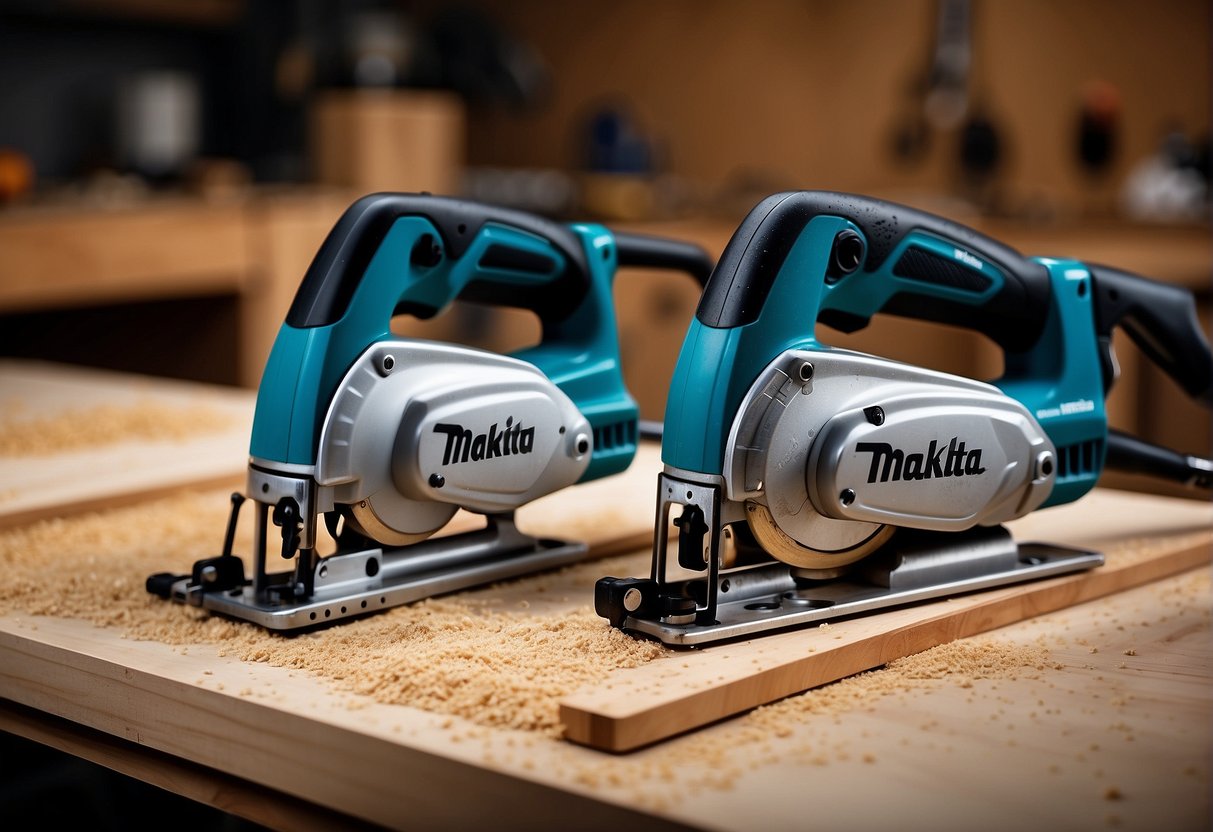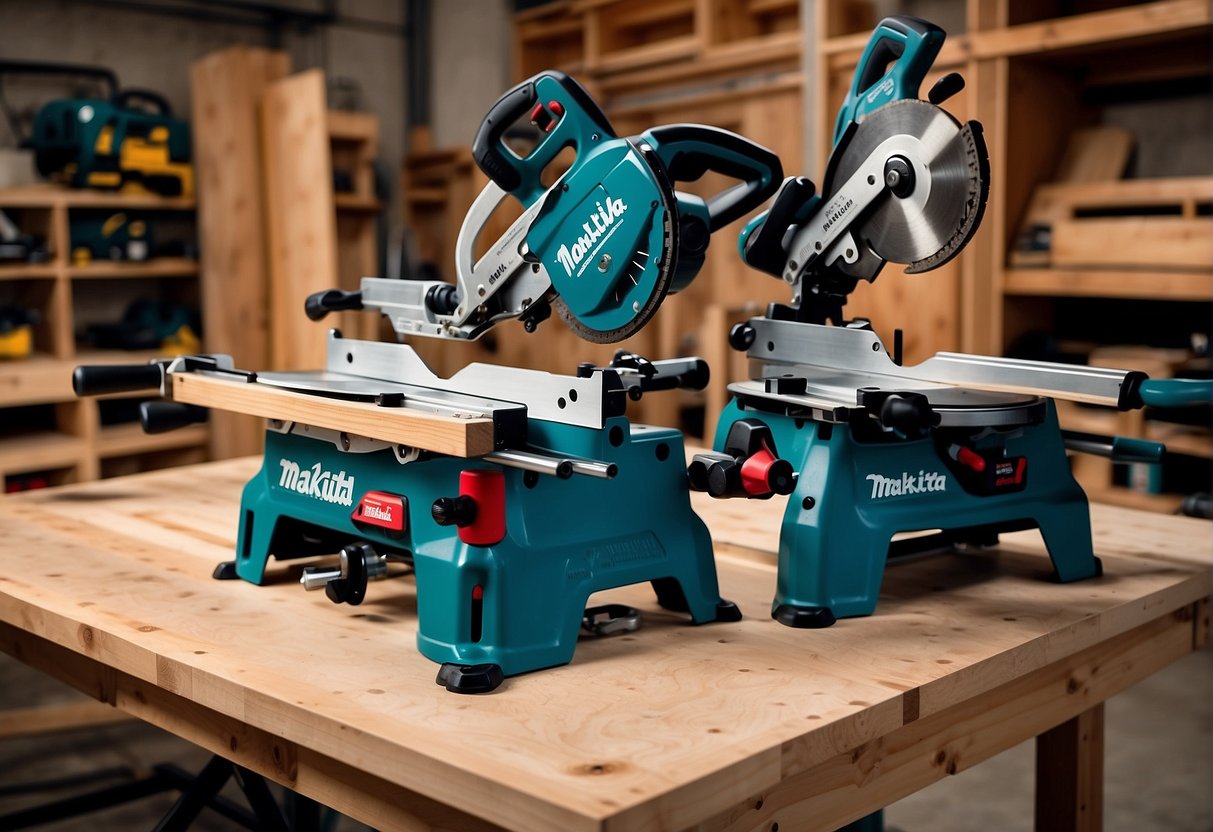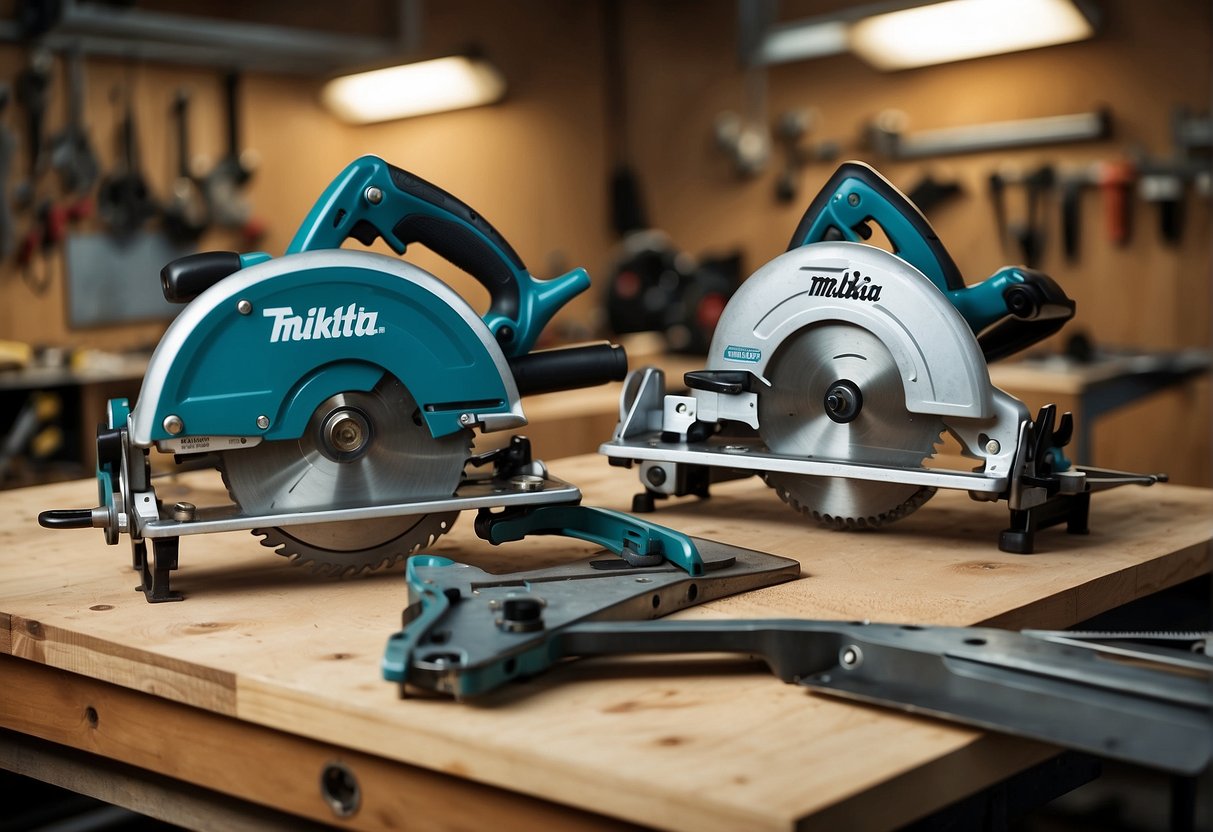Makita and Bosch are two of the most popular brands when it comes to miter saws. Both brands have an extensive range of products that cater to different needs and budgets. Choosing between the two can be a daunting task, especially for those who are new to woodworking or DIY projects. In this article, I will provide an overview of Makita and Bosch miter saws, compare key features and technologies, and analyze their performance and versatility to help you make an informed decision.
Makita and Bosch are both known for their high-quality products and innovative technologies. Makita is a Japanese company that has been in business for over 100 years. They are known for their cordless power tools and have a wide range of miter saws that cater to different needs. Bosch, on the other hand, is a German company that has been in business for over 130 years. They are known for their precision engineering and have a range of miter saws that are designed for both professionals and DIY enthusiasts.
Key Takeaways
- Makita and Bosch are two of the most popular brands when it comes to miter saws.
- Both brands have an extensive range of products that cater to different needs and budgets.
- Choosing between the two can be a daunting task, but understanding the key features and technologies can help make an informed decision.
Overview of Makita and Bosch Miter Saws
As a professional contractor, I have used both Makita and Bosch miter saws over the years. Both brands are known for producing high-quality power tools, but they each have their own unique strengths and weaknesses. In this section, I will provide an overview of Makita and Bosch miter saws, including their brand history, design philosophy, and a comparison of two popular models: the Makita LS1019L and the Bosch GCM12SD.
Brand History
Makita was founded in 1915 in Nagoya, Japan, and has since become a leading manufacturer of power tools for both professionals and DIY enthusiasts. The company’s mission is to create innovative products that are both reliable and efficient, and they have a reputation for producing some of the most durable tools on the market.
Bosch, on the other hand, was founded in 1886 in Stuttgart, Germany, and has a long history of producing high-quality engineering and technology products. The company’s power tools division was established in 2003, and they have since become a popular choice for professionals and DIYers alike.
Makita LS1019L vs Bosch GCM12SD
When it comes to miter saws, Makita and Bosch both offer a variety of models to choose from. Two popular options are the Makita LS1019L and the Bosch GCM12SD.
The Makita LS1019L is a 10-inch dual-bevel sliding compound miter saw that is designed for accuracy and efficiency. It features a compact design that makes it easy to transport and store, and it has a powerful motor that can handle even the toughest cutting tasks.
The Bosch GCM12SD, on the other hand, is a 12-inch dual-bevel sliding compound miter saw that is known for its precision and versatility. It features a unique glide system that allows for smooth and accurate cuts, and it has a powerful motor that can handle a wide range of cutting applications.
Design Philosophy
Both Makita and Bosch have a design philosophy that emphasizes durability, efficiency, and user-friendliness. Makita is known for producing tools that are compact and lightweight, making them easy to transport to job sites. Bosch, on the other hand, is known for its innovative features, such as the glide system found on the GCM12SD, which allows for smoother and more accurate cuts.
In conclusion, while both Makita and Bosch are known for producing high-quality miter saws, each brand has its own unique strengths and weaknesses. When choosing between the two, it is important to consider factors such as the size of the saw, the power of the motor, and the specific features that are most important to you.
Key Features and Technologies
When it comes to miter saws, both Makita and Bosch offer a range of features and technologies that set them apart from other brands. Here are some of the key features and technologies that you should consider when choosing between the two:
Cutting Capacity and Precision
One of the most important features of any miter saw is its cutting capacity and precision. Both Makita and Bosch offer miter saws with large cutting capacities and high levels of accuracy. For example, the Makita LS1019L has a cutting capacity of 6-5/8″ at 90 degrees and 4-3/4″ at 45 degrees, while the Bosch GCM12SD has a cutting capacity of 14″ at 90 degrees and 6-1/2″ at 45 degrees. Both saws also feature laser guides to help you make accurate cuts.
Power and Motor Efficiency
Another important feature to consider is power and motor efficiency. Makita and Bosch both offer miter saws with powerful motors that can handle even the toughest cutting tasks. For example, the Makita LS1019L has a 15-amp motor that delivers 3,200 RPM, while the Bosch GCM12SD has a 15-amp motor that delivers 3,800 RPM. Both saws also feature soft start technology that helps to reduce start-up torque and extend the life of the motor.
Safety and Dust Collection
Safety and dust collection are also important considerations when choosing a miter saw. Both Makita and Bosch offer miter saws with safety features such as electric brakes and blade guards to help prevent accidents. In addition, both saws feature dust collection systems that help to keep your work area clean and free of debris. The Makita LS1019L features a dust collection system that captures up to 75% of dust, while the Bosch GCM12SD features an axial glide system that helps to reduce dust and debris buildup.
Overall, both Makita and Bosch offer high-quality miter saws that are packed with features and technologies to help you get the job done. Whether you’re a professional contractor or a DIY enthusiast, there’s a miter saw out there that’s perfect for your needs.
Performance and Versatility
When it comes to performance and versatility, both Makita and Bosch miter saws are known for their precision and accuracy. However, there are some differences to consider when choosing between the two.
Miter and Bevel Capabilities
Makita miter saws are known for their dual bevel capabilities, which allow for greater flexibility and precision when making angled cuts. The Makita LS1019L, for example, has a dual bevel capacity of up to 48 degrees left and right, making it ideal for a wide range of projects.
On the other hand, Bosch miter saws are known for their precision and accuracy when it comes to miter and bevel angles. The Bosch GCM12SD, for example, has a miter range of 52 degrees left and right, and a bevel range of 47 degrees left and right, making it ideal for precision cuts.
Portability and Workspace Compatibility
When it comes to portability and workspace compatibility, Makita miter saws are generally lighter and more compact than their Bosch counterparts. The Makita LS1019L, for example, weighs just 57.9 pounds, making it easy to move around the workshop or job site.
On the other hand, Bosch miter saws are known for their stability and durability, making them ideal for heavy-duty projects. The Bosch GCM12SD, for example, has a durable handle and a compact design that makes it easy to transport and store, while still providing the stability needed for precision cuts.
Overall, both Makita and Bosch miter saws offer excellent performance and versatility, with each brand having its strengths and weaknesses. When choosing between the two, it’s important to consider your specific needs and preferences, as well as the type of projects you’ll be working on.
Comparative Analysis
When it comes to choosing between Makita and Bosch miter saws, there are several factors to consider. In this section, I will compare the two brands based on price to value consideration and professional use vs DIY projects.
Price to Value Consideration
One of the most important factors to consider when purchasing a miter saw is the price to value consideration. Makita and Bosch offer a range of miter saws at different price points. While Makita saws are generally more expensive, they offer a higher level of quality and durability. Bosch saws, on the other hand, are more budget-friendly and offer good value for the money.
If you are a professional woodworker or contractor, it might be worth investing in a high-end Makita saw. However, if you are a DIYer or a hobbyist, a Bosch saw might be a better choice as it offers good value for the money.
Professional Use vs DIY Projects
Another factor to consider when choosing between Makita and Bosch miter saws is the intended use. Makita saws are designed for heavy-duty use and are preferred by professionals. They offer a high level of precision and accuracy, making them ideal for professional use.
Bosch saws, on the other hand, are more suitable for DIY projects and hobbyists. They offer good value for the money and are easy to use, making them a great choice for beginners.
In conclusion, both Makita and Bosch offer high-quality miter saws that cater to different needs. While Makita saws are generally more expensive, they offer a higher level of quality and durability, making them ideal for professional use. Bosch saws, on the other hand, are more budget-friendly and offer good value for the money, making them a great choice for DIYers and hobbyists.
Additional Considerations
When choosing between the Makita and Bosch miter saws, there are a few additional factors to consider beyond the cutting capacity and features. Here are a few things to keep in mind:
Warranty and Customer Service
Both Makita and Bosch offer limited warranties on their miter saws. Makita offers a 1-year warranty on parts and labor, while Bosch offers a 1-year limited warranty. However, Bosch does offer an extended warranty program that can provide up to 3 years of coverage. When it comes to customer service, both companies have a reputation for being responsive and helpful.
Accessories and Compatibility
When purchasing a miter saw, it’s important to consider what accessories are available and whether they are compatible with the saw. Both Makita and Bosch offer a range of accessories, including blades, stands, and dust collection systems. However, it’s important to double-check compatibility, especially if you have an older model of the saw.
For those who use other power tools from a particular manufacturer, it may be worth considering whether the miter saw is compatible with the same battery system. Both Makita and Bosch offer cordless saws that are compatible with their respective battery systems, which can be a convenient option for those who already own other cordless tools from the same manufacturer.
Overall, both Makita and Bosch offer high-quality 12-inch sliding miter saws that are well-suited for a range of cutting tasks. By considering factors such as warranty, customer service, and accessory compatibility, you can make an informed decision about which saw is the best fit for your needs.
Frequently Asked Questions
What are the main differences in specifications between Makita and Bosch miter saws?
Makita and Bosch miter saws have some differences in specifications. For example, Makita miter saws tend to have a higher RPM (revolutions per minute) than Bosch miter saws, which means they can make more cuts per minute. Additionally, Makita miter saws have a larger cutting capacity than Bosch miter saws, which can be useful for larger projects. On the other hand, Bosch miter saws tend to be more compact and lightweight than Makita miter saws, which can make them easier to transport and store.
Which brand offers the best performance in compound miter saws?
Both Makita and Bosch are known for producing high-quality compound miter saws. However, some experts believe that Makita has a slight edge when it comes to performance. Makita miter saws are known for their precision, accuracy, and smoothness, which can be especially important when making compound cuts.
How does the Bosch Glide Miter Saw compare to the Makita Sliding Miter Saw in terms of functionality?
The Bosch Glide Miter Saw and the Makita Sliding Miter Saw are both highly functional tools that can be used for a variety of cutting tasks. However, there are some differences between the two. The Bosch Glide Miter Saw is known for its smooth and precise cutting action, while the Makita Sliding Miter Saw is known for its power and versatility. Ultimately, the choice between the two will depend on your specific needs and preferences.
What are the advantages of using a miter saw with a shadow line feature?
A miter saw with a shadow line feature can be incredibly useful for making accurate and precise cuts. The shadow line feature creates a shadow that shows exactly where the blade will make contact with the material, which can help you line up your cuts more accurately. This can be especially helpful when making complex cuts or working with delicate materials.
Can you find zero clearance miter saws in Makita or Bosch’s product lines?
Yes, both Makita and Bosch offer zero clearance miter saws in their product lines. Zero clearance miter saws are designed to eliminate the gap between the blade and the fence, which can help prevent tear-out and improve accuracy.
Are there any notable differences in build quality and durability between Makita and Bosch miter saws?
Both Makita and Bosch are known for producing high-quality and durable miter saws. However, some experts believe that Makita miter saws are slightly more durable than Bosch miter saws. Makita miter saws are built to withstand heavy use and can last for many years with proper care and maintenance.

Hi, I’m Sal Muller of Tooltrip.com. My DIY experience led me to understand essential power tools for home projects. Tooltrip.com guides enthusiasts and professionals in choosing right tools for any job. I provide concise top tool reviews for easier, efficient DIY.




